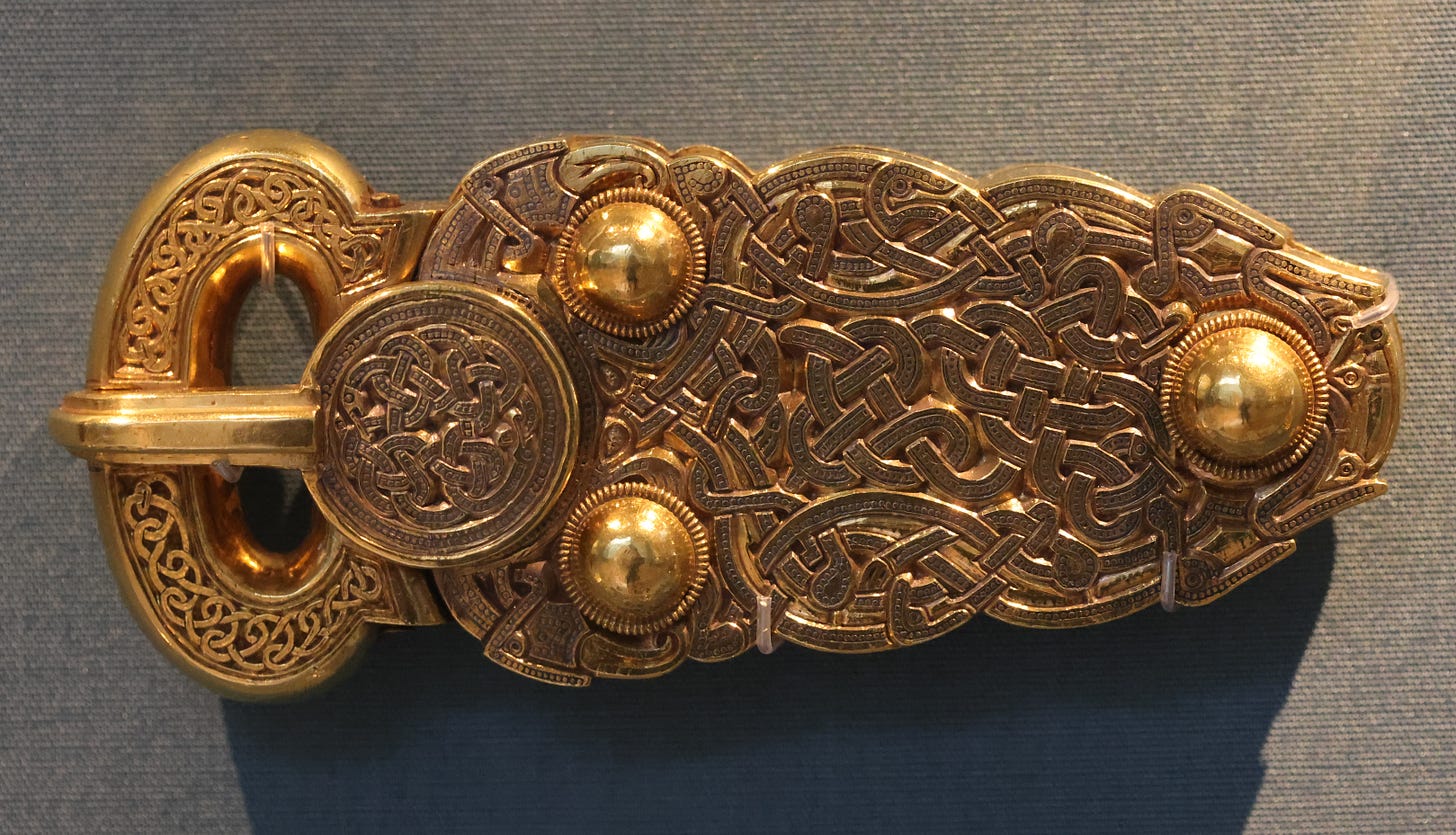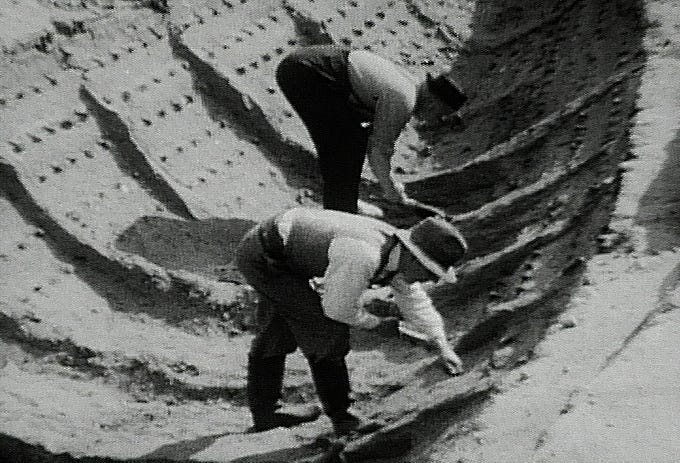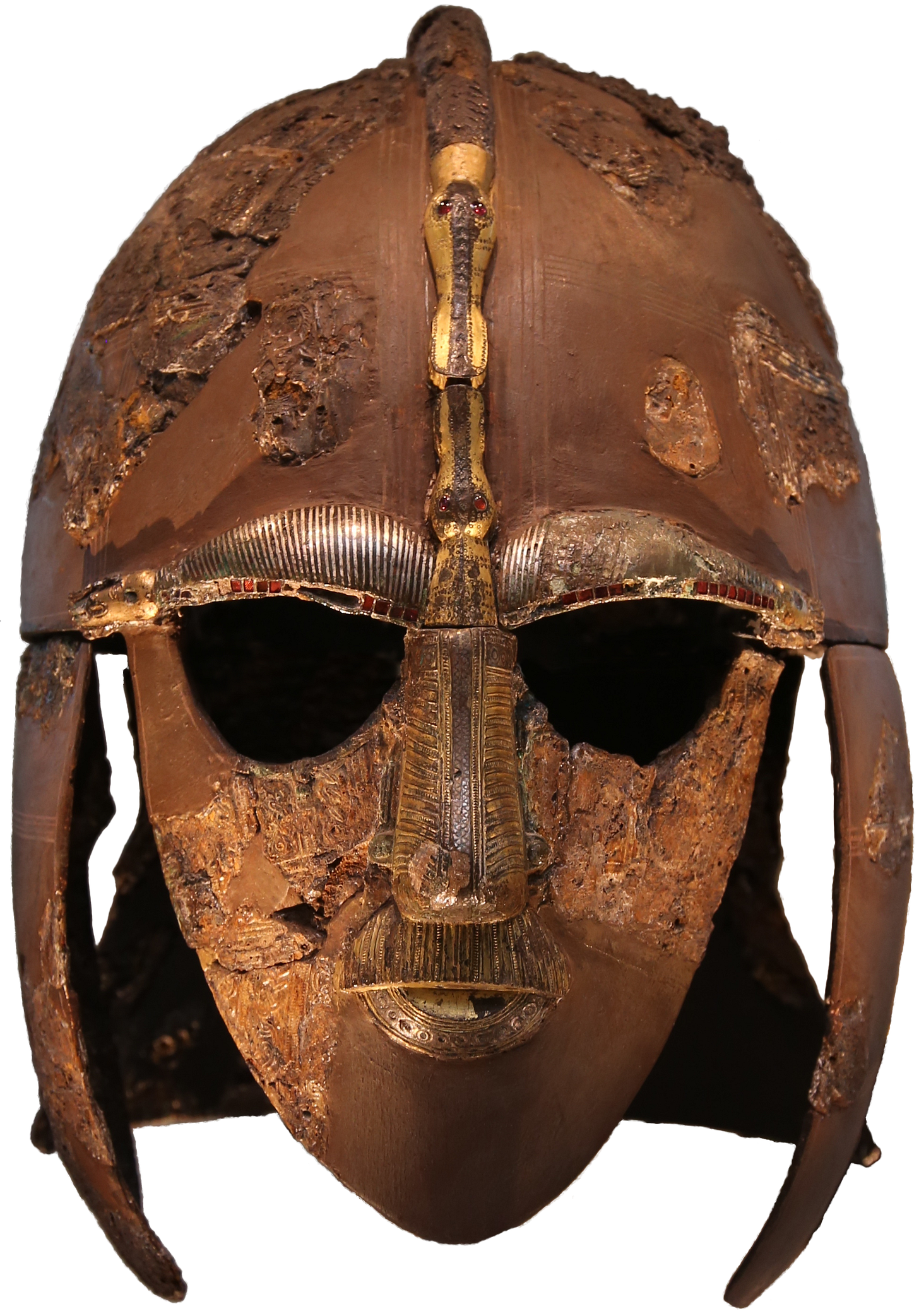Hello, Dear Reader
Today, we’ll be traveling to the quiet countryside of England, specifically Suffolk, to discover a series of ancient burial mounds that once held a mystery buried for over a thousand years. Beneath one of them lay one of the most significant archaeological discoveries in European history: a 7th-century Anglo-Saxon ship burial known as Sutton Hoo.
This was no ordinary grave.
It was a detailed glimpse into the artistry, belief systems, and global connections of an early medieval society—one far more advanced than many once assumed.

The Discovery
In 1939, on the eve of World War II, a landowner named Edith Pretty enlisted local archaeologist Basil Brown to investigate the grassy mounds on her estate near the River Deben. While excavating Mound 1, Brown uncovered the impression of a 27-meter-long wooden ship—the timber long decayed, but its shape perfectly preserved by the acidic soil.
Inside were remnants of an elaborate ship burial, a rite likely reserved for royalty or nobility. Though no body survived, the presence of extravagant grave goods made its purpose unmistakable.
The discovery was momentous, but war intervened. The dig paused, and the treasures were swiftly safeguarded in the London Underground. When the war ended, Sutton Hoo re-emerged into public awareness, revealing a cultural legacy that forever changed our understanding of early medieval Britain.
Why a Ship?
In Anglo-Saxon culture, ships symbolized passage, both literal and spiritual. A burial of this kind likely represented a journey to the afterlife. Whoever was interred here was sent off in the vessel of a warrior-king, surrounded by objects that reflected status, belief, and craftsmanship. The absence of a body only deepens the mystery of who this figure was, but every object offers a clue.
Gold, Garnets, and Gods: Artistry of a Lost World
The treasures from Sutton Hoo aren’t just impressive—they’re revelatory. Each piece demonstrates technical mastery and cultural richness that challenge older views of the Anglo-Saxons as unsophisticated.
The Gold Buckle
One of the most iconic finds is a large gold belt buckle, weighing nearly a pound. Its surface features an intricate pattern of interlaced beasts—an example of the “animal interlace” style common in early medieval art. Likely used to hold relics, the buckle also hints at the overlap between pagan and Christian influences during a time of spiritual transition.

The Shoulder Clasps
These curved clasps, made of gold and garnet, once fastened a cloak or armor. Their cloisonné technique—tiny compartments filled with cut gems—echoes Roman craftsmanship. The imagery, including boars (symbols of bravery in Germanic cultures), suggests a blending of classical techniques with local mythology.

The Purse Lid
This ornate purse lid held coins from the Merovingian Frankish kingdom, indicating strong trade ties. The imagery—predators and warriors—symbolizes both wealth and dominion. These coins not only date the grave to around 610–630 CE, but also show how interconnected this part of Britain was with continental Europe.
The Helmet
Perhaps the most iconic object is the iron helmet, reconstructed from fragments into a haunting mask. Its design features a dragon crest, stylized eyebrows, and etched warrior scenes. This helmet wasn’t simply armor, it was likely ceremonial—a display of authority and identity.
Cultural Canvas is a reader-supported publication. Every like, comment, share, and donation helps us grow—your support truly matters!
Rethinking the ‘Dark Ages’
The Sutton Hoo find helped rewrite the cultural narrative of early medieval Britain. Once seen as a cultural void between Roman Britain and Norman England, the Anglo-Saxon era now stands as a period of innovation, artistry, and global exchange.
Craftsmanship: The intricate metalwork reveals aesthetic sophistication that rivals the finest pieces from anywhere in medieval Europe.
Trade and Travel: Items from Byzantium, Frankish territories, and even garnets potentially sourced from South Asia demonstrate a far-reaching network.
Political Significance: The grave likely belonged to Raedwald, a 7th-century king of East Anglia. His reign marked a turning point in England’s religious and political history, as he navigated both Christian and pagan traditions.
Literary Parallels: The grandeur of the ship burial calls to mind the funerary scenes in Beowulf, bridging literature and archaeological record in evocative ways.
Other royal burials from medieval Europe—like Childeric I’s tomb in France or the Oseberg ship burial in Norway—each offer unique insights. Yet Sutton Hoo stands apart. Its blend of artistic detail, spiritual symbolism, and political context makes it a singular window into a formative era.
An Ongoing Mystery
The missing body is part of what gives Sutton Hoo its enduring allure. Was it a cremation? A symbolic burial? Or has the body simply disappeared with time?
Every interpretation offers a different story about how this society understood death, honor, and legacy.
More recent discoveries nearby, including warrior burials with horses, suggest that the site may have been a royal necropolis. This deepens the significance of Sutton Hoo not just as a singular burial, but as part of a broader cultural landscape.
Visiting Sutton Hoo Today
Managed by the National Trust, Sutton Hoo is open to visitors who can walk the mounds and explore a replica ship burial. The original treasures are housed at the British Museum, but the site offers its own quiet power.
Sutton Hoo isn’t just about gold and garnets. It’s about a people who sought to define power, identity, and legacy in a shifting world. Their story invites us to reconsider our definitions of ‘civilization’—and to ask what evidence of our own world might endure for future generations.
When future archaeologists uncover our time, what stories will they find?
What vessels will we have sent sailing into memory?
Missed our last story? Read it here↓
Don’t miss the newest episode of our podcast!








When I was teaching, humanities, the book only talked about the purse lid. There was so much more to this find and windows into this culture. I never liked that humanities text, and now I see another reason why. Great article! Thank you. We can’t know everything about everything, but it is helpful to go more deeply into things we do know.